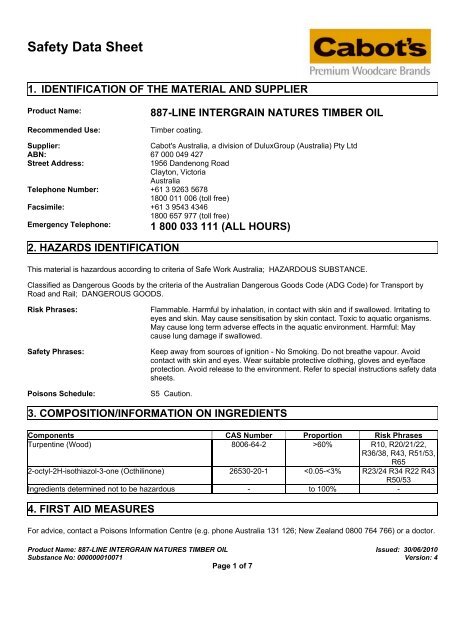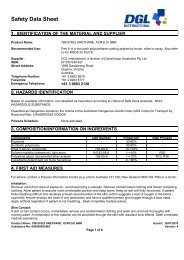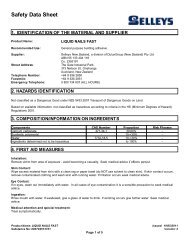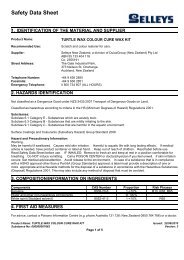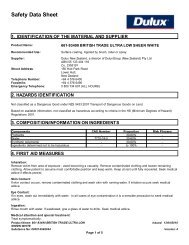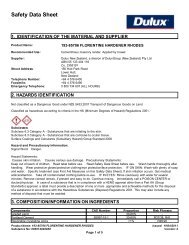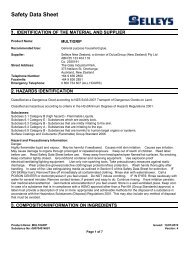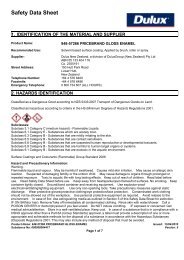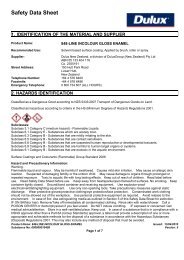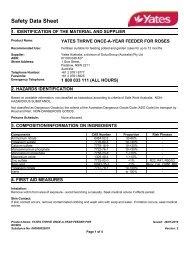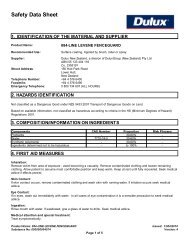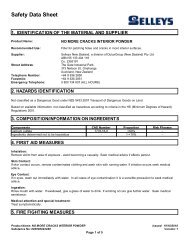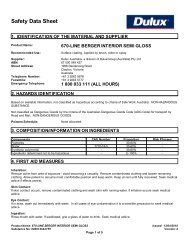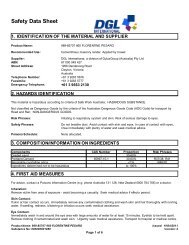intergrain natures timber oil - MSDS
intergrain natures timber oil - MSDS
intergrain natures timber oil - MSDS
Create successful ePaper yourself
Turn your PDF publications into a flip-book with our unique Google optimized e-Paper software.
Safety Data Sheet<br />
1. IDENTIFICATION OF THE MATERIAL AND SUPPLIER<br />
Product Name: 887-LINE INTERGRAIN NATURES TIMBER OIL<br />
Recommended Use: Timber coating.<br />
Supplier: Cabot's Australia, a division of DuluxGroup (Australia) Pty Ltd<br />
ABN: 67 000 049 427<br />
Street Address: 1956 Dandenong Road<br />
Clayton, Victoria<br />
Australia<br />
Telephone Number: +61 3 9263 5678<br />
1800 011 006 (toll free)<br />
Facsimile: +61 3 9543 4346<br />
1800 657 977 (toll free)<br />
Emergency Telephone: 1 800 033 111 (ALL HOURS)<br />
2. HAZARDS IDENTIFICATION<br />
This material is hazardous according to criteria of Safe Work Australia; HAZARDOUS SUBSTANCE.<br />
Classified as Dangerous Goods by the criteria of the Australian Dangerous Goods Code (ADG Code) for Transport by<br />
Road and Rail; DANGEROUS GOODS.<br />
Risk Phrases: Flammable. Harmful by inhalation, in contact with skin and if swallowed. Irritating to<br />
eyes and skin. May cause sensitisation by skin contact. Toxic to aquatic organisms.<br />
May cause long term adverse effects in the aquatic environment. Harmful: May<br />
cause lung damage if swallowed.<br />
Safety Phrases: Keep away from sources of ignition - No Smoking. Do not breathe vapour. Avoid<br />
contact with skin and eyes. Wear suitable protective clothing, gloves and eye/face<br />
protection. Avoid release to the environment. Refer to special instructions safety data<br />
sheets.<br />
Poisons Schedule: S5 Caution.<br />
3. COMPOSITION/INFORMATION ON INGREDIENTS<br />
Components CAS Number Proportion Risk Phrases<br />
Turpentine (Wood) 8006-64-2 >60% R10, R20/21/22,<br />
R36/38, R43, R51/53,<br />
R65<br />
2-octyl-2H-isothiazol-3-one (Octhilinone) 26530-20-1
Safety Data Sheet<br />
Inhalation:<br />
Remove victim from area of exposure - avoid becoming a casualty. Remove contaminated clothing and loosen remaining<br />
clothing. Allow patient to assume most comfortable position and keep warm. Keep at rest until fully recovered. If patient<br />
finds breathing difficult and develops a bluish discolouration of the skin (which suggests a lack of oxygen in the blood -<br />
cyanosis), ensure airways are clear of any obstruction and have a qualified person give oxygen through a face mask.<br />
Apply artificial respiration if patient is not breathing. Seek immediate medical advice.<br />
Skin Contact:<br />
If skin or hair contact occurs, immediately remove any contaminated clothing and wash skin and hair thoroughly with<br />
running water. If swelling, redness, blistering or irritation occurs seek medical assistance.<br />
Eye Contact:<br />
If in eyes, hold eyelids apart and flush the eye continuously with running water. Continue flushing until advised to stop by<br />
a Poisons Information Centre or a doctor, or for at least 15 minutes.<br />
Ingestion:<br />
If swallowed, do NOT induce vomiting. Give a glass of water. Get to a doctor or hospital quickly.<br />
Medical attention and special treatment:<br />
Treat symptomatically.<br />
5. FIRE FIGHTING MEASURES<br />
Hazards from combustion products:<br />
Flammable liquid. On burning will emit toxic fumes, including those of oxides of carbon .<br />
Precautions for fire fighters and special protective equipment:<br />
Keep containers cool with water spray. Fire fighters to wear self-contained breathing apparatus and suitable protective<br />
clothing if risk of exposure to vapour or products of combustion.<br />
Suitable Extinguishing Media:<br />
Alcohol resistant foam is the preferred firefighting medium but, if it is not available, normal protein foam can be used.<br />
Hazchem Code: · 3Y<br />
6. ACCIDENTAL RELEASE MEASURES<br />
Emergency procedures:<br />
If contamination of sewers or waterways has occurred advise local emergency services.<br />
Methods and materials for containment and clean up:<br />
SMALL SPILLS: Wipe up with rag or absorbent paper. Collect in a container for disposal via special chemical waste<br />
collection.<br />
LARGE SPILLS: Shut off all possible sources of ignition. Wear protective equipment to prevent skin and eye contact.<br />
Avoid breathing in vapours. Work up wind or increase ventilation. Contain - prevent run off into drains and waterways.<br />
Use absorbent (s<strong>oil</strong>, sand or other inert material). Collect and seal in properly labelled containers or drums for disposal.<br />
7. HANDLING AND STORAGE<br />
This material is a Scheduled Poison S5 and must be stored, maintained and used in accordance with the relevant<br />
regulations.<br />
Product Name: 887-LINE INTERGRAIN NATURES TIMBER OIL Issued: 30/06/2010<br />
Substance No: 000000010071 Version: 4<br />
Page 2 of 7
Safety Data Sheet<br />
Conditions for safe storage:<br />
Store in a well ventilated area away from foodstuffs, oxidising agents and sources of heat or ignition. Keep containers<br />
closed when not in use - check regularly for leaks.<br />
Precautions for safe handling:<br />
Keep out of reach of children. Avoid skin and eye contact and breathing in vapour. May form flammable vapour mixtures<br />
with air. All potential sources of ignition (open flames, pilot lights, furnaces, spark producing switches and electrical<br />
equipment etc) must be eliminated both in and near the work area. Do NOT smoke. Vapour may travel a considerable<br />
distance to source of ignition and flash back.<br />
8. EXPOSURE CONTROLS/PERSONAL PROTECTION<br />
Occupational Exposure Limits: No value assigned for this specific material by the National Occupational Health and<br />
Safety Commission. However, Exposure Standard(s) for constituent(s):<br />
Turpentine (wood): 8hr TWA = 557 mg/m 3 (100 ppm), Sen<br />
As published by the National Occupational Health and Safety Commission.<br />
No Exposure Standards assigned to other constituents.<br />
TWA - The time-weighted average airborne concentration over an eight-hour working day, for a five-day working week<br />
over an entire working life.<br />
`Sen' Notice - sensitiser. The substance can cause a specific immune response in some people. An affected individual<br />
may subsequently react to exposure to minute levels of that substance.<br />
These Exposure Standards are guides to be used in the control of occupational health hazards. All atmospheric<br />
contamination should be kept to as low a level as is workable. These exposure standards should not be used as fine<br />
dividing lines between safe and dangerous concentrations of chemicals. They are not a measure of relative toxicity.<br />
Engineering controls:<br />
Provide adequate ventilation. If using indoors, keep windows and doors open during use. Keep containers closed when<br />
not in use.<br />
Personal Protective Equipment:<br />
The selection of PPE is dependant on a detailed risk assessment. The risk assessment should consider the work<br />
situation, the physical form of the chemical, the handling methods, and environmental factors.<br />
Personal Protection: H - OVERALLS, SAFETY SHOES, CHEMICAL GOGGLES, GLOVES, RESPIRATOR.<br />
Product Name: 887-LINE INTERGRAIN NATURES TIMBER OIL Issued: 30/06/2010<br />
Substance No: 000000010071 Version: 4<br />
Page 3 of 7
Safety Data Sheet<br />
MANUFACTURE, PACKAGING AND TRANSPORT: Wear overalls, chemical goggles and impervious gloves. Use with<br />
adequate ventilation. If inhalation risk exists wear organic vapour/particulate respirator or air supplied mask meeting the<br />
requirements of AS/NZS 1715 and AS/NZS 1716. Always wash hands before smoking, eating, drinking or using the t<strong>oil</strong>et.<br />
Wash contaminated clothing and other protective equipment before storage or re-use.<br />
FOR CONSUMER USE: Avoid contact with eyes and skin. Use with adequate ventilation. If risk of inhalation exists, wear<br />
organic vapour/particulate respirator meeting the requirements of AS/NZS 1715 and AS/NZS 1716.<br />
9. PHYSICAL AND CHEMICAL PROPERTIES<br />
Physical state: Liquid<br />
Colour: Coloured<br />
Odour: Solvent<br />
Solubility: Insoluble in water. Soluble in organic solvents.<br />
Specific Gravity: 0.89 @20°C<br />
Relative Vapour Density (air=1): >1<br />
Vapour Pressure (20 °C): Not available<br />
Flash Point (°C): 32<br />
Flammability Limits (%): Not available<br />
Autoignition Temperature (°C): Not available<br />
% Volatile by Volume: Not available<br />
Solubility in water (g/L): Insoluble<br />
Melting Point/Range (°C): Not applicable<br />
B<strong>oil</strong>ing Point/Range (°C): Not available<br />
Decomposition Point (°C): Not available<br />
pH: Not applicable<br />
Viscosity: Not available<br />
Evaporation Rate: Not available<br />
10. STABILITY AND REACTIVITY<br />
Chemical stability: Stable under normal conditions of use.<br />
Conditions to avoid: Avoid exposure to heat, sources of ignition, and open flame.<br />
Incompatible materials: Incompatible with oxidising agents.<br />
Hazardous decomposition<br />
products:<br />
Oxides of carbon.<br />
Hazardous reactions: Hazardous polymerisation will not occur.<br />
11. TOXICOLOGICAL INFORMATION<br />
No adverse health effects expected if the product is handled in accordance with this Safety Data Sheet and the product<br />
label. Symptoms or effects that may arise if the product is mishandled and overexposure occurs are:<br />
Product Name: 887-LINE INTERGRAIN NATURES TIMBER OIL Issued: 30/06/2010<br />
Substance No: 000000010071 Version: 4<br />
Page 4 of 7
Safety Data Sheet<br />
Ingestion: Swallowing can result in nausea, vomiting and central nervous system depression. If<br />
the victim is showing signs of central system depression (like those of drunkeness)<br />
there is greater likelihood of the patient breathing in vomit and causing damage to<br />
the lungs. Breathing in vomit may lead to aspiration pneumonia (inflammation of the<br />
lung).<br />
Eye contact: An eye irritant.<br />
Skin contact: Contact with skin will result in irritation. A skin sensitiser. Repeated or prolonged<br />
skin contact may lead to allergic contact dermatitis.<br />
Inhalation: Material may be irritant to the mucous membranes of the respiratory tract (airways).<br />
Breathing in vapour can result in headaches, dizziness, drowsiness, and possible<br />
nausea. Breathing in high concentrations can produce central nervous system<br />
depression, which can lead to loss of co-ordination, impaired judgement and if<br />
exposure is prolonged, unconsciousness.<br />
Long Term Effects:<br />
No information available for the product.<br />
Toxicological Data: No LD50 data available for the product.<br />
12. ECOLOGICAL INFORMATION<br />
Ecotoxicity Avoid contaminating waterways.<br />
Aquatic toxicity: Toxic to aquatic organisms. May cause long term adverse effects in the aquatic<br />
environment.<br />
13. DISPOSAL CONSIDERATIONS<br />
Disposal methods:<br />
For large quantities: Refer to Waste Management Authority. Advise flammable nature. Dispose of material through a<br />
licensed waste contractor. Normally suitable for incineration by an approved agent.<br />
For small quantities: Do not pour leftover paint down the drain. Unwanted paint should be brushed out on newspaper,<br />
allowed to dry and then disposed of via domestic waste collection. Empty paint containers should be left open in a well<br />
ventilated area to dry out. When dry recycle the container via steel can recycling programs. Disposal of empty paint<br />
containers via domestic recycling programs may differ between local authorities. Check with your local council first.<br />
14. TRANSPORT INFORMATION<br />
Road and Rail Transport<br />
Classified as Dangerous Goods by the criteria of the Australian Dangerous Goods Code (ADG Code) for Transport by<br />
Road and Rail; DANGEROUS GOODS.<br />
FLAMMABLE<br />
LIQUID<br />
3<br />
UN No: 1263<br />
Product Name: 887-LINE INTERGRAIN NATURES TIMBER OIL Issued: 30/06/2010<br />
Substance No: 000000010071 Version: 4<br />
Page 5 of 7
Safety Data Sheet<br />
Class-primary 3 Flammable Liquid<br />
Packing Group: III<br />
Proper Shipping Name: PAINT<br />
Hazchem Code: · 3Y<br />
Marine Transport<br />
Classified as Dangerous Goods by the criteria of the International Maritime Dangerous Goods Code (IMDG Code) for<br />
transport by sea; DANGEROUS GOODS.<br />
UN No: 1263<br />
Class-primary: 3 Flammable Liquid<br />
Packing Group: III<br />
Proper Shipping Name: PAINT<br />
Air Transport<br />
Classified as Dangerous Goods by the criteria of the International Air Transport Association (IATA) Dangerous Goods<br />
Regulations for transport by air; DANGEROUS GOODS.<br />
UN No: 1263<br />
Class-primary: 3 Flammable Liquid<br />
Packing Group: III<br />
Proper Shipping Name: PAINT<br />
15. REGULATORY INFORMATION<br />
Classification: This material is hazardous according to criteria of Safe Work Australia;<br />
HAZARDOUS SUBSTANCE.<br />
Hazard Category: Xn: Harmful<br />
Xi: Irritant<br />
Risk Phrase(s): R10: Flammable.<br />
R20/21/22: Harmful by inhalation, in contact with skin and if swallowed.<br />
R36/38: Irritating to eyes and skin.<br />
R43: May cause sensitisation by skin contact.<br />
R51/53: Toxic to aquatic organisms, may cause long-term adverse effects in the<br />
aquatic environment.<br />
R65: Harmful: May cause lung damage if swallowed.<br />
Safety Phrase(s): S16: Keep away from sources of ignition - No smoking.<br />
S23: Do not breathe vapour/mist/aerosol.<br />
S24/25: Avoid contact with skin and eyes.<br />
S36/37/39: Wear suitable protective clothing, gloves and eye/face protection.<br />
S61: Avoid release to the environment. Refer to special instructions Safety Data<br />
Sheets.<br />
Poisons Schedule: S5 Caution.<br />
All the constituents of this material are listed on the Australian Inventory of Chemical Substances (AICS).<br />
Product Name: 887-LINE INTERGRAIN NATURES TIMBER OIL Issued: 30/06/2010<br />
Substance No: 000000010071 Version: 4<br />
Page 6 of 7
Safety Data Sheet<br />
16. OTHER INFORMATION<br />
Reason(s) for Issue:<br />
Alignment to HSNO requirements<br />
This safety data sheet has been prepared by SH&E Shared Services.<br />
This SDS summarises to our best knowledge at the date of issue, the chemical health and safety hazards of the material<br />
and general guidance on how to safely handle the material in the workplace. Since DuluxGroup Limited cannot anticipate<br />
or control the conditions under which the product may be used, each user must, prior to usage, assess and control the<br />
risks arising from its use of the material.<br />
If clarification or further information is needed, the user should contact their DuluxGroup representative or DuluxGroup<br />
Limited at the contact details on page 1.<br />
DuluxGroup Limited's responsibility for the material as sold is subject to the terms and conditions of sale, a copy of which<br />
is available upon request.<br />
Product Name: 887-LINE INTERGRAIN NATURES TIMBER OIL Issued: 30/06/2010<br />
Substance No: 000000010071 Version: 4<br />
Page 7 of 7


